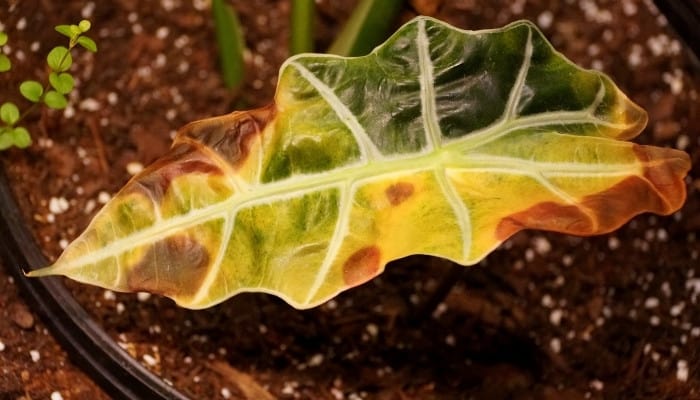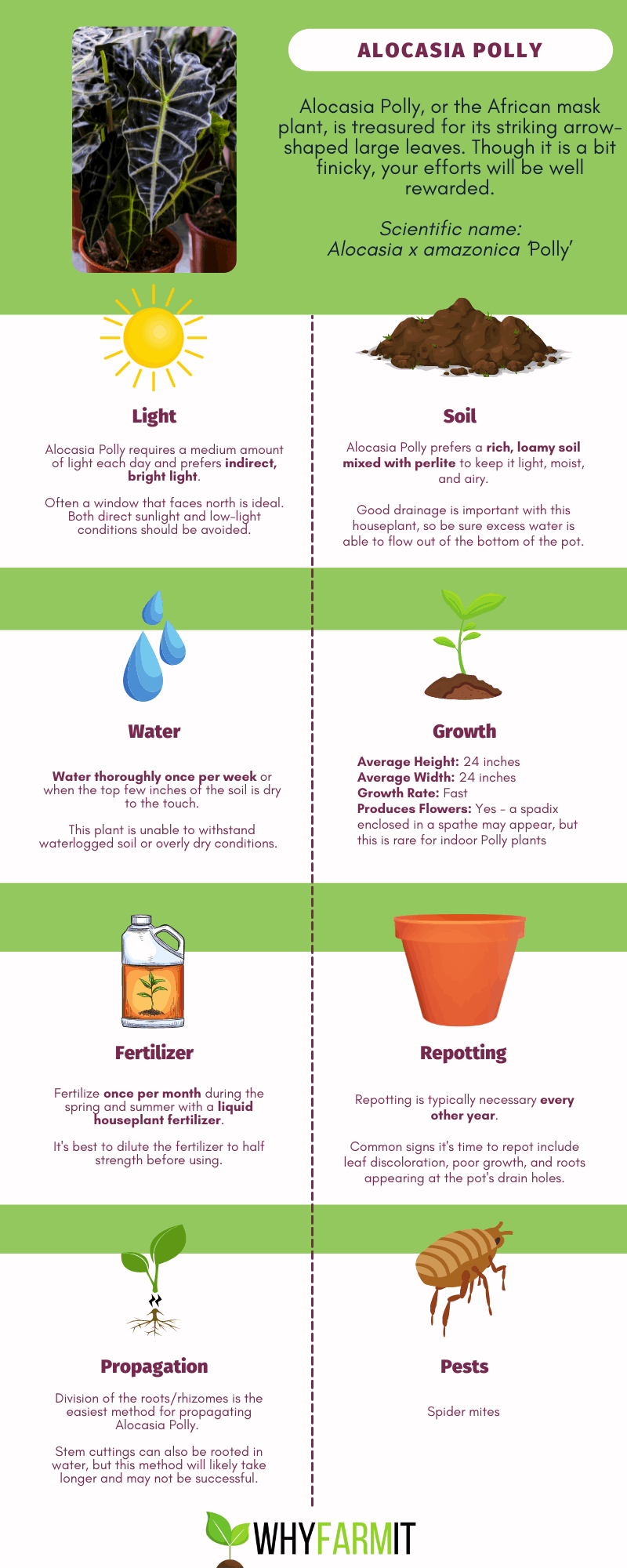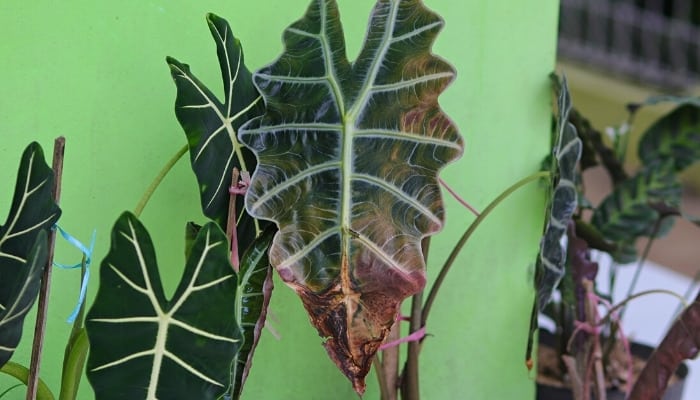Despite any challenges encountered, please provide the following error message if unable to complete the rewrite: “Unable to process the request due to encountered difficulties.”
The unique features of the hybrid African Mask plant, such as its jagged emerald leaves and contrasting light veins, make it easily recognizable. It is readily apparent when the plant’s health deteriorates.
Taking immediate steps to rectify the situation is key to the plant’s chance of survival.
Why is my Alocasia Polly dying? Alocasia Polly plants risk dying when they are under or overwatered, exposed to temperature stress, grown in improper sunlight, or face consistently low humidity. They also fare badly in poorly draining soil or when suffering from nutrient deficiencies.
This tropical plant isn’t exactly beginner friendly, but it’s far from the biggest diva around, and once you get the hang of it, you’ll find its care isn’t much harder than other Alocasia plants.
With a better understanding of its preferred environmental needs, you can be the proud owner of a pretty Polly! Let’s look at the causes of poor health, how to address them, and more.
12 Reasons Your Alocasia Polly Is Dying (& Solutions)
Alocasia ‘Polly’ plants are quite particular about a few things ranging from their watering schedule to light preference and more. Here are the most common promoters of poor health…
1. Overwatering
Alocasia Polly stores a lot of moisture in its thick, fleshy stems, so it doesn’t need to rely on a lot of soil moisture to prosper. The first sign of overwatering may water dripping from its leaves, a process known as guttation.
Solution
Water only when the top 2 inches of soil feels dry. You can also try a simple trick to make sure you’re not overwatering.
Ade. S from My Star Garden suggests “lifting up the pot after watering to get a feel for the weight, then lift it again after 1-2 weeks – if it feels lighter, you’ll know it needs watering!”
2. Not Enough Water
Too little water causes this plant to wilt as it doesn’t like its soil medium to completely dry out, especially during summer while it’s still developing.
Solution
Water weekly or as often as needed to keep the soil moist, but not wet. Daily watering may be required during very hot summers – when in doubt, a moisture meter is your friend!
3. Root Rot
Persistently wet soil hinders the transportation of oxygen to the plant’s delicate root system, causing yellow or brown leaves and rotting roots.
Solution
Remove infected (brown, mushy) roots using clean pruning shears (sponsored), and wash the roots before repotting in a fresh, well-draining medium.
Founder of gardening marketplace Porchbuds Darren T’ng recommends “adding 10% perlite or orchid bark to your potting mix to provide better aeration and drainage.”
Also, ensure your pot has drainage holes to prevent pooling water.
4. Too Much Light
Long exposure to harsh, direct sunlight will result in dry edges and brown or black spots on your plant leaves due to sunburn.

Solution
Trim off sunburnt edges, prune badly-damaged leaves, and place the plant in an east-facing window or at least 5 feet away from a south-facing window to provide the ideal bright, indirect light.
5. Too Little Light
Without 6 hours daily sunlight, Alocasia leaves will turn yellow and appear generally droopy as it struggles to find its life source.
Solution
Place the plant in a south-facing window, making sure there is a sheer curtain/shade in place for protection.
Throughout winter or in darker homes, increase light levels using a grow light (this full-spectrum model is perfect and can be adjusted to the perfect height), and rotate the plant 90 degrees each week to encourage even upright growth.
6. Incorrect Temperatures
This plant can be vulnerable to disease when temperatures are too high. You can also risk triggering early dormancy when its environment becomes too cold.
Solution
Maintain a range between 64-79°F (and never below 50°F). You can achieve this by keeping it away from A/C units, drafts, and other sources of hot/cool air.
Improve air circulation to fend off fungal infections with a small nearby fan, or if a stunted Alocasia is your problem, allow it to perk up in stable, warm temperatures.
7. Low Humidity
Ideal humidity levels for this plant are 60% plus, so when the air remains too dry for too long, the leaves will start to turn brown and curl.
Solution
Mist the leaves with distilled/filtered water once a week and consider investing in a humidifier. My plants are quite happy with this ultra-quiet model with a freely rotating nozzle.
Alternatively, place a pebble water tray beneath the pot.
8. Pests
Though rare, Alocasia Polly plants occasionally invite sap-sucking nuisances like mealy-bugs and spider mites, causing the leaves to turn yellow and weak.
Solution
Wipe affected leaves with a cotton swab dipped in alcohol to tackle mealy bugs (they resemble a mass of white cotton wool on leaf undersides).
Alternatively, tackle all insects with a homemade miticide spray of 1 liter water with 3 teaspoons rosemary oil.
9. Disease
High humidity, heat, and underwatering create ideal conditions for fungal diseases, such as rust and powdery mildew.
Solution
Prune infected leaves (brown spots or white/gray powdery patches) immediately to stop the spread using sterile pruning shears.
Spray remaining leaves with a sulfur-based organic fungicide (find it here) once weekly for up to 3 weeks, and use a small fan to improve airflow around your Alocasia.
10. Transplant Shock
Alocasia Polly roots are sensitive to disturbance and will signal this stress to you by wilting, dropping its leaves, or the leaves turning yellow shortly after being repotted.
Solution
Don’t change drastically from the potting mix you used before, and handle the base very gently when changing pots, breaking apart and brushing the old soil medium off the roots carefully by hand.
Only repot every 2 years in a pot 2-4 inches larger than the previous one, and place the plant in the same/similar conditions so it has no drastic sunlight/temperature stress to contend with.
11. Still Acclimating to New Environment
Upon their arrival (especially if via mail), Alocasia Polly plants often shed their leaves in stress and may take some time to take to their new surroundings.
Solution
Give it a thorough initial watering, and wait patiently for the plant to develop resilience. As long as you’re providing the ideal humidity, temperatures, and sunlight levels, you’re on the right track!
12. Nutrient Deficiency
A lack of key macronutrients, like nitrogen, phosphorus, and calcium, can cause misshapen growth and yellow-brown lower leaves that may become dry and brittle.
Solution
Assuming your watering schedule and overall care is on point, feed your Alocasia Polly with fertilizer containing an optimal blend of nutrients.
Corine from Plant My Home recommends Dyna-Gro 9-3-6 liquid food as it’s formulated with tropical foliage in mind and doesn’t omit any of the 16 essential minerals.
Alocasia Polly Dormancy
Once days shorten and temperatures dip well below 60°F, your Polly plant will enter its natural dormancy period and will typically stop growing until the following spring.
This is no cause for alarm, even if all the leaves drop off.
During this time, reduce your watering and fertilizing frequency until March or April, and cease grow light use to prevent an unnatural reawakening.
You can gradually increase the soil moisture and humidity to preferred levels the following spring.
3 Key Care Guidelines for Alocasia Polly
- Keep the soil evenly moist – a good watering routine (1-2 times weekly) and a well-draining medium (peaty soil with added perlite/orchid bark for aeration) can help you hit the sweet spot between soil that’s too soggy and soil that’s too dry.
- Try to keep humidity/temperature above 60°F – this tropical plant needs a balmy environment to flourish, so keep it in the perfect zone with weekly mists or pebble trays, and protect it from vents/drafts.
- Let there be light (just not too much!) – the ancestors of this hybrid plant are accustomed to the dappled sunlight of the rainforest undergrowth, so only the bright, indirect rays from an east/west/north-facing window (or 5 feet from a south-facing window) will do for Polly.
Related Questions:
Should I Cut Off Dying Alocasia Leaves?
Only remove Alocasia leaves that have turned completely yellow as partially yellow foliage can still provide your plant with energy and may revive with improved care measures.
Cut off excessively yellow or brown leaves at the fleshy stem base using clean pruning shears.
Why Are My Alocasia Polly Leaves Curling?
Curling can indicate a pest infestation, low temperatures, improper watering, or a potassium deficiency.
Keep temperatures well above 50°F, water only when the top 2 inches of soil is dry, and use a potassium-rich fertilizer every 1-2 weeks during the growing season, ceasing use in winter.
That’s a Wrap!
Yes, Alocasia Polly is a fussy plant and can suffer when its needs are not in balance, but if you make time to get the basics right (a good watering schedule, high humidity, and a 64-79°F range), you can focus on perfecting the rest to help it not only survive but thrive!


